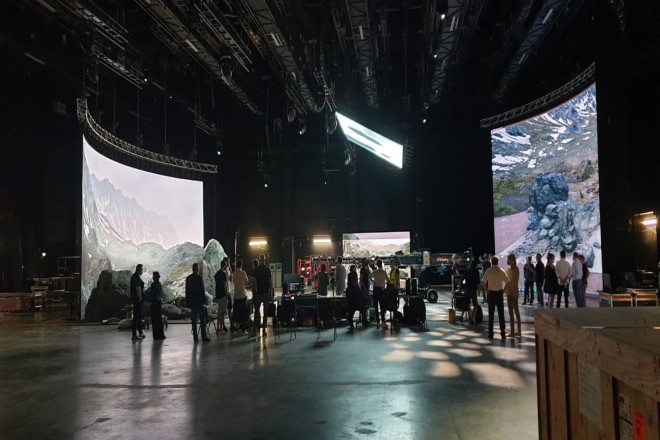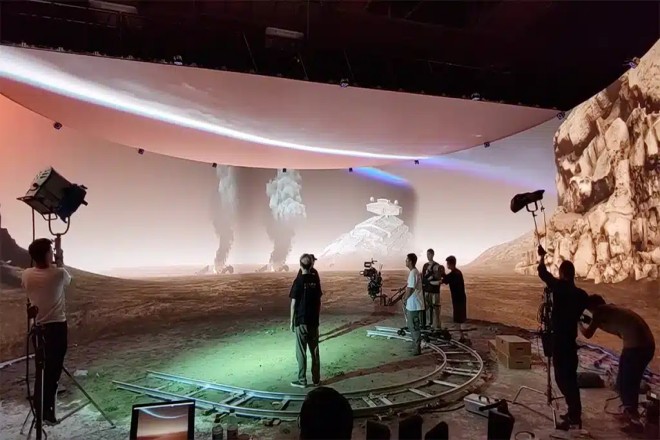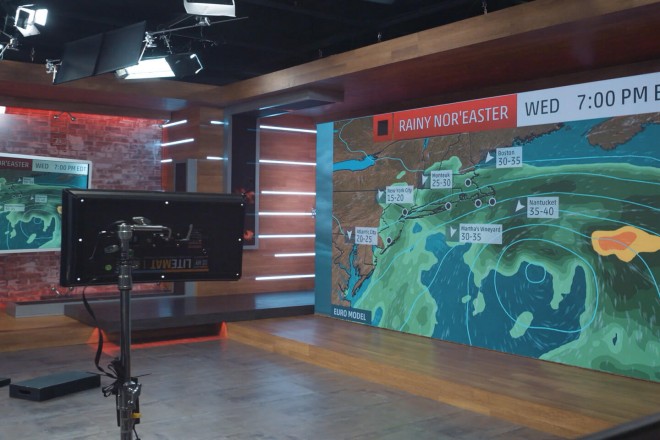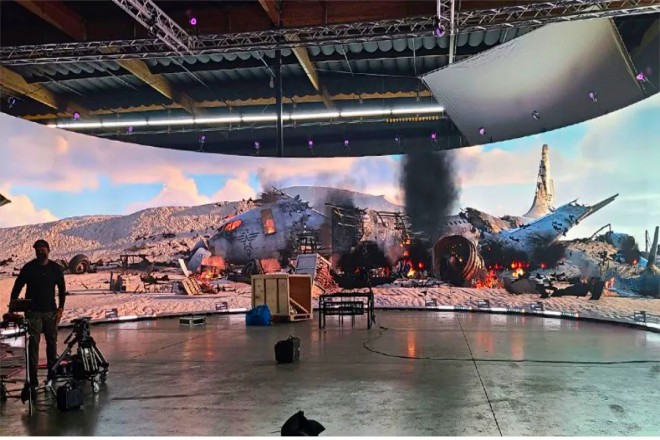Introduction

Embarking on the wonderful journey of virtual production, every step is full of exploration and surprise.
Behind this visual feast, LED display screens are quietly becoming the core force driving the transformation of film and television production.
This article goes straight to the point and will reveal to you the extraordinary role of LED display screens in virtual production – from how to create an immersive visual experience to how to optimize the production process, and then to leading the future development trend of the industry.
1. LED display screens provide an immersive experience

LED display screens play a vital role in providing an immersive experience, mainly due to their high definition and realistic color performance capabilities.
The following is a detailed explanation of this, combined with examples from “The Mandalorian” while exploring how this immersive experience enhances the appeal and influence of virtual production content.
1). High definition and realistic color:
- Technical basis:
LED display screens use advanced pixel pitch technology to present extremely clear and delicate images and text. It has a wide color gamut and high contrast and can accurately restore a variety of colors from deep night sky blue to bright flower red, making the display content more vivid and infectious.
- Immersive experience:
This high-definition and realistic color performance allows the audience to feel as if they are in the scene when watching.
Whether it is displaying exquisite works of art, complex scientific charts, or playing high-definition videos, LED displays allow the audience to not miss any details, thus providing a more immersive viewing experience.
2). Examples in “The Mandalorian”:
- Technical combination:
In the filming of “The Mandalorian,” the LED background wall is combined with real-time rendering technology to achieve the fusion of “virtual computer images” and “real actor performances.” This technology allows the special effects screen to be visualized on the set, allowing creators to see the effect close to the final film.
- Immersive shooting:
Surrounded by a 270° LED background wall, the scene light presented on the background wall gives the armor extremely realistic colors and reflections so that the light perception of the Mandalorian armor does not need to be adjusted in the later stage and naturally forms a real texture under the mapping of the LED background wall.
This immersive shooting and production method realizes the seamless fusion of virtual and real, bringing an unprecedented viewing experience to the audience.
3). The impact of immersive experience on virtual production content:
- Enhance the appeal and influence:
Through the immersive experience provided by the LED display, the content of virtual production can be presented to the audience more vividly. This immersive feeling makes the audience more easily attracted by the content, thereby enhancing the appeal and influence of virtual production content.
- Enhance creative flexibility:
In the filming of “The Mandalorian,” the combination of LED background wall and real-time rendering technology not only realizes immersive shooting but also greatly improves the flexibility of creation.
The director and the main creator can complete real-time feedback and digital content processing during the production process to promote the shooting process more efficiently.
2. The role and function of LED display in virtual production

1). On-site visualization and interactivity: Seamless integration of virtual and reality
- On-site visualization: Intuitive experience of the virtual world
Imagine that you are an actor standing in front of a huge LED display. This screen does not simply play a video but displays a virtual world generated by a computer in real-time.
You can see the mountains, rivers, buildings, and even weather changes in this virtual world. This intuitive feeling is like you are really standing in a brand-new environment. This is the on-site visualization achieved by the LED display.
This visualization is also very important for directors. They can see the integration of the actor’s performance and the virtual environment through the screen so as to make real-time adjustments.
- Interactivity: A bridge between virtual and reality
The LED display is not only a display tool; it can also interact with the actors. Through special tracking technology, when the actors move or make movements in front of the screen, the virtual world on the screen will change accordingly.
This interaction makes it easier for actors to integrate into the virtual environment and perform more naturally.
For example, in a virtual concert, singers can dance in front of the LED display, and the virtual background on the screen will be adjusted in real-time according to the singer’s movements, creating an immersive feeling.
- Improve the atmosphere and naturalness of the performance.
The LED display can also simulate different light effects by changing parameters such as color, brightness and contrast. For example, it can simulate the afterglow of the sunset, the starry sky at night or the rainbow after the rain.
These light effects not only enhance the atmosphere of the scene, but also make the actors’ performances more natural and vivid.
2). Improve post-production efficiency: A fast channel from shooting to filming
- Real-time rendering: What you see is what you get
In virtual production, LED displays can render high-quality virtual scenes in real-time. This means that the director and production team can see the effect close to the final film on the set.
This real-time rendering technology greatly reduces the workload of post-production because many effects have been completed on the set.
- Shorten the production cycle.
Due to the real-time rendering function of the LED display, the production team can try and adjust multiple times on the set until the best effect is found. This instant feedback mechanism greatly shortens the production cycle because many decisions can be made on the spot.
- Reduce costs
Real-time rendering technology also reduces the cost of post-production. Because many effects have been completed on the set, the post-production team does not need to spend a lot of time and energy on keying, color grading or adding special effects. This saves manpower and material costs.
3). Save set cost and time: Unlimited possibilities of virtual scenes
- Reduce the demand for outdoor shooting scenes
In virtual production, LED displays can simulate various actual scenes. This means that the production team no longer needs to shoot on the spot, thus saving time and cost.
For example, if you want to shoot a battle scene in the desert, but there is no suitable desert location in reality, then you can use LED displays to simulate this scene.
- Fast scene change
Another advantage of LED displays is that they can quickly switch between different scenes. This means that the production team can complete the shooting of multiple scenes in a short period of time.
For example, in a movie, you may need to switch from a city street to another indoor scene. With LED display screens, you can achieve this switch by simply adjusting the picture on the screen without rebuilding the physical scene.
3. What are the optimizations of LED display screens for virtual manufacturing?

The application of LED display screens in film and television production, especially in the field of virtual shooting, has brought revolutionary changes to the filming process. It not only enables virtual shooting to achieve the effect of “what you see is what you get” but also greatly reduces the workload of post-production and improves the efficiency of shooting production.
The following is a detailed explanation and analysis of these aspects, and examples are cited for illustration.
1). LED display screen achieves the effect of “what you see is what you get.”
The LED display screen is a large display screen composed of several LED units with high-definition and high-performance image processing technology.
In virtual shooting, the LED display screen is used as a photographic background to present virtual environments and special effects in real-time.
This real-time rendering technology allows actors, directors, and photographers to see the effect close to the final film on the set, realizing “what you see is what you get.”
Specifically, the virtual scene is generated by Unreal Engine or other real-time rendering engines and projected onto the LED display screen. When the actors perform in front of the screen, they can see the virtual environment intuitively and interact as needed.
This intuitiveness makes it easier for the actors to integrate into the virtual world and perform more naturally. At the same time, the camera can capture the correct reflection and shadow effects between the actors and the virtual environment, further enhancing the realism of the picture.
2). LED display reduces the workload of post-production and improves the efficiency of shooting production
The application of LED displays in virtual shooting not only improves the effect of on-site shooting but also greatly reduces the workload of post-production.
Since the effect close to the final film can be seen on the shooting site, the production team can make multiple attempts and adjustments during the shooting process until the best effect is found. This instant feedback mechanism greatly shortens the production cycle because many decisions can be made on the spot.
In addition, LED display can also be combined with motion capture technology and game engine real-time rendering technology to achieve more complex virtual scenes and special effects. These technologies make it possible to shoot the final picture directly in the camera, thus avoiding the tedious special effects synthesis and color grading work in the later stage.
3). Case Analysis: The combination of LED display and Unreal Engine in “Lone Moon.”
“Lone Moon” is an important milestone in the process of China’s film industry. This film is the first to integrate Unreal Engine technology with traditional film production processes, and uses the new process to complete the production of the entire lunar environment.
Among them, LED display screens play a key role in virtual shooting.
In “Lone Moon”, the production team used high-quality LED display screens as the photography background, and combined with Unreal Engine technology to render virtual scenes in real time.
When the actors perform in front of the screen, they can intuitively see the environment and other virtual elements on the lunar surface. This intuitiveness makes it easier for the actors to integrate into the virtual world and perform more naturally. At the same time, the images captured by the camera also show a high sense of reality and delicacy.
In addition, “Lone Moon” also uses motion capture technology and game engine real-time rendering technology to achieve more complex virtual scenes and special effects. The combination of these technologies has brought the film to a new height in visual effects.
Conclusion
In summary, the application of LED displays in virtual production not only greatly enriches visual expression but also significantly improves production efficiency and flexibility, bringing revolutionary changes to the film and television industry.
As technology continues to advance, the resolution, color reproduction, and interactivity of LED displays will continue to improve, further broadening the boundaries of virtual production.
Finally, if you want to learn more about LED displays, please get in touch with us.
